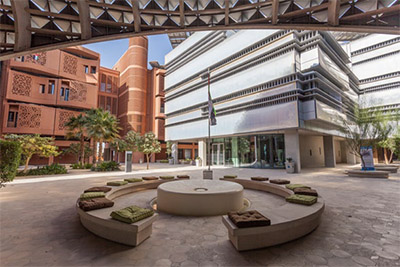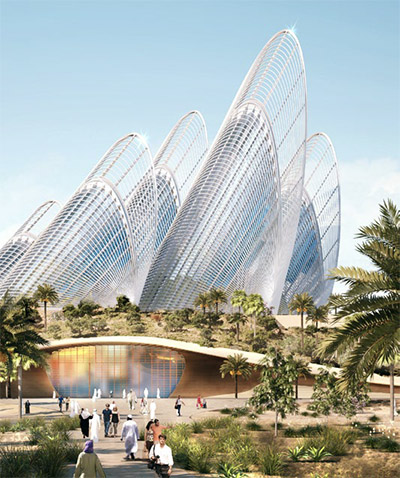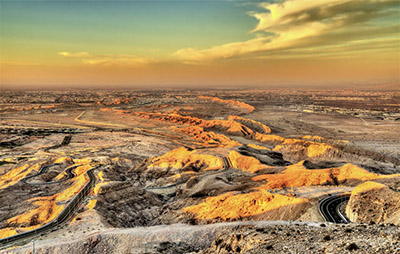Where do we start? About 990 feet up is as good a place as any. We get there by express elevator, from ground level to the 74th floor of the Etihad Towers in 60 seconds. With our ears popping, we step out onto the polished marble floor and find Abu Dhabi spread before us like an architect’s scale model.
Directly below us lies the opulent Emirates Palace hotel. The flag of the United Arab Emirates coils and uncoils languidly from a pole at the focal point of the hotel’s symmetrically neat gardens.
Moving around to the eastern panoramic windows, we look along the length of the Corniche, curving starkly against the glassy green-blue waters of the Arabian Gulf. Receding along it, and clustered most densely at the hazy far end, the silhouettes of sleekly modern skyscrapers.
This is not a fixed skyline. It transforms by the month as new floors are added to the many buildings under construction and new foundation pits are excavated. To fully appreciate Abu Dhabi’s leap into the future, we have with us aerial photographs taken in the 1970s. A couple of roads and one or two landmarks provide our bearings, but everything else has changed.
Even the coastline has altered radically. Land reclamation reshaped the line of the Corniche and added new peninsulas and offshore islands. Today’s view is just a snapshot. In another decade or two it will be as out of date as the 1970s photographs.
Immediately parallel to the Corniche, the flat, tawny, empty expanse of Lulu Island is currently earmarked for development, with plans for a centerpiece 1,300-foot skyscraper, the Lulu Tower. Next time we gain a bird’s-eye view of Abu Dhabi, it may well be from there.
Abu Dhabi’s skyline is both the result of its oil wealth and an integral part of efforts to make the economy less oil-dependent. For now, the black gold flows in abundance, with the emirate accounting for about a tenth of the world’s proven reserves. Those reserves, however, are expected to decline sharply this century. Consequently, Abu Dhabi is already preparing for life without oil.

Masdar Institute of Science and Technology © TYPHOONSKI | DREAMSTIME.COM
At Masdar City, currently under construction close to Abu Dhabi International Airport, 11 miles southeast of downtown, the aspiration to reduce the emirate’s dependence on petroleum is taken to extremes. This $22 billion project aims to create the world’s first carbon-neutral city, powered almost entirely by solar and other renewable energy sources. The city is ultimately intended to house up to 50,000 people and to serve as a focal point for research and development in green energy.
The realities of the harsh desert environment forced the planners to revise their ambitions. Periodic sandstorms compromise the efficiency of the solar panels, making the carbon-neutral target unrealistic. In addition, the fall in the price of oil tightened budgets across Abu Dhabi, slowing the pace of development. Completion, originally slated for this year, has slipped to 2030. Even that may be optimistic.

Zayed National Museum of the U.A.E. © ZAYED NATIONAL MUSEUM OF UAE
Economic realities have also caught up with Abu Dhabi’s other showpiece project, Saadiyat Island. This ambitious $27 billion scheme, a kind of highbrow Disneyland, will boast the first outpost of the Louvre outside of France, as well as a breathtaking Frank Gehry-designed Guggenheim museum. Other attractions will include the Zayed National Museum designed by Norman Foster + Partners and a futuristic Performing Arts Centre designed by the late Zaha Hadid.
In common with Masdar City, Saadiyat should be nearing completion, but reduced oil income forced a much more conservative timetable. The fabulously delicate Louvre building, designed by Jean Nouvel, is expected to open in late 2016 (more than three years behind schedule). Work is yet to begin on many of the other attractions.
The recent forecast of 5 percent economic growth in 2017 increased hopes that Abu Dhabi weathered the worst of the downturn, having slashed government spending by 20 percent to compensate for dramatically reduced oil revenue. When oil prices begin to recover, Abu Dhabi’s economy will be leaner and more robust than before the crash.
In part, the emirate’s successful navigation of challenging times is a legacy of history and geography. The Emiratis are a hardy, desert people. Before the discovery of oil, they trekked across the desert from oasis to oasis or eked out a living from the waters of the Arabian Gulf. (For centuries, pearls were the major export from these shores.)
The future is always hard to predict. It is unlikely anyone standing on the Corniche in the 1970s could have envisioned today’s skyline. Similarly, from our high vantage in the Etihad Towers, even our best guess of what the city will look like in 40 years will probably fall short of reality. But we can be sure whatever challenges and opportunities lie ahead, Abu Dhabi is well-equipped to make the most of them.
Things to Do in Abu Dhabi
Abu Dhabi is the largest and richest of the seven emirates that make up the United Arab Emirates (the others are Ajman, Dubai, Fujairah, Ras al-Khaimah, Sharjah and Umm al-Quwain). The interior, largely low-lying desert, features occasional rugged outcrops of high ground and a scattering of lush oases.
The highest mountain, at 4,098 feet, is Jebel Hafeet, the summit of which can be reached by one of the world’s most hair-raising highways, making 60 hairpin turns from bottom to top. The reward is a panoramic view over much of Abu Dhabi and into neighboring Oman. At the foot of the mountain lies the oasis settlement of Al Ain, the Garden City; a vivid burst of greenery in the midst of stark aridity.

View from Jebel Hafeet mountain toward Al Ain © LEONID ANDRONOV | DREAMSTIME.COM
There are plenty of attractions within the city of Abu Dhabi. The most spectacular, the Sheikh Zayed Grand Mosque, cost $545 million to build and used materials from all corners of the globe, symbolically uniting the world in one building. The architecture draws inspiration from across the Islamic world, with elements of Moroccan, Persian and Arab styles. Non-Muslim visitors are welcome (admission free), though it is important to observe the dress code. Shorts and sleeveless tops are not permitted, and women must wear a headscarf and loose-fitting trousers or a skirt long enough to cover the ankles.
Abu Dhabi Heritage Village, on a peninsula looking across at downtown, provides a glimpse of life in the emirate before oil wealth. There are reconstructions of a traditional Bedouin village and a souq. From the village’s walls you only need to flick your gaze across the water to see how far Abu Dhabi has come.
Yas Waterworld offers a great place to escape the oppressive heat of summer with 43 watery rides. This is one place in which the conservative dress code is relaxed, and Western swimming costumes — including bikinis for women — are permitted.
Close by lies the Yas Marina Circuit, one of the world’s most impressive motor racing tracks. The circuit hosts the Abu Dhabi Formula 1 Grand Prix each November. When there are no major races taking place, behind-the-scenes tours are available, with several participatory options. You can experience the circuit at high speed as a passenger or sign up for a motor racing course. There are even driving lessons available for 11- to 17-year-olds.
CHECKING IN WITH ARJUN MUKERJI
Director, Haris Al Afaq
How long have you been doing business in Abu Dhabi?
My father set up the group of companies in 1968 when the U.A.E. was still a British Dependency called the Trucial States. Our Abu Dhabi branch company was opened in the mid-1970s, so we have grown along with the tremendous growth of the U.A.E.
What opportunities does Abu Dhabi offer American investors?
Abu Dhabi, with 10 percent of the planet’s proven reserves of oil, has a range of opportunities beyond the oil and gas industry and associated projects. Over the past five years there has been a boom in tourism-related developments, with golf courses, 5-star hotels, the Formula 1 racetrack and marina at Yas Island, and tourism development at Saadiyat Island. The Louvre and Guggenheim museums are currently under development and slated to be completed in the coming years. Infrastructure development is ongoing at a tremendous pace with a new metro system. Four nuclear power stations, the first in the Arab world, are under construction and will begin supplying electricity in 2017.
What cultural differences should American investors be aware of when doing business in Abu Dhabi?
The Arab world can be confusing for Americans. The concepts of time and deadlines are flexible and can be extremely frustrating to people used to certainties. A “black and white” approach just does not work here. Due to the extremely fast development of the region, laws can also be a bit opaque and somewhat contradictory. This can be a huge problem, as straight answers to questions are difficult to find. Add to that the lack of reliable statistics and numbers, and doing business here can be a challenge, especially to newcomers.
What are the key future developments to look for?
With the collapse of the oil price over the past couple of years, developments have slowed down, especially as the U.A.E. is unaccustomed to running deficit budgets. That said, the U.A.E. has one of the world’s largest sovereign wealth funds, and coupled with a low local population that means the country is certainly well-placed for the future in a turbulent area. However, given the deficit, it is expected taxes will be introduced. It has been one of the few countries with no income or corporate taxes. This is expected to change, with a value-added tax being imposed next year, soon to be followed by corporate and personal income taxes, no doubt.
What attraction in Abu Dhabi and the U.A.E. do you particularly recommend?
The Yas Marina and F1 racetracks are interesting from a tourist perspective. In the south of Abu Dhabi, on the border with Saudi Arabia, are the uninhabited spaces and massive sand dunes of the Empty Quarter. The Qasr Al Sarab Desert Resort is absolutely amazing for a couple of days. Al Ain is another area of interest. It is the second-largest city in the Abu Dhabi Emirate. The ride up to the top of Jebel Hafeet mountain is spectacular.
Abu Dhabi Info to Go
Scheduled international flights arrive at Abu Dhabi International Airport (AUH), 19 miles east of downtown. The airport is the main hub for Etihad Airways, operating non-stop flights to every inhabited continent. The airport offers border preclearance for flights to the United States.
Abu Dhabi: Just the Facts
Time zone: GMT +4
Phone code: Country code: 971 City code: 2
Entry/exit requirements: All U.S. citizens require a passport valid for at least six months beyond arrival and a confirmed round-trip airline ticket. Visas are available on arrival for stays of up to one month. If you require an extension, contact the immigration office in Abu Dhabi.
Currency: Dirham
Official language: Arabic, though English is widely spoken. Other languages include Persian, Hindi and Urdu.
Key industries: Oil and gas, financial services, tourism, real estate
Where to Stay in Abu Dhabi
Emirates Palace Abu Dhabi It cost $3 billion to build and claims to be the world’s first 7-star hotel. Prepare to be dazzled by gold leaf and marble. West Corniche Road $$$$
Le Royal Méridien Abu Dhabi The most recent makeover left the rooms looking a little bland, but they’re spacious and airy, with a good location. Sheikh Khalifa Street $$$$
Southern Sun Abu Dhabi The unpretentious, modern, 4-star hotel offers good value for money, located just one block back from the Corniche. Al Mina Street $$$
Restaurants in Abu Dhabi
Asia de Cuba This outpost of a well-established brand in London and New York is located at The St. Regis Hotel on the Corniche. As the name suggests, it serves Asian cuisine with a Latin twist. The St. Regis Hotel, Corniche Road, Nation Riviera Beach Club $$$
Hakkasan Abu Dhabi An Abu Dhabi special-occasion venue since 2010, situated in the Emirates Palace hotel, offers modern Cantonese food in sumptuous surroundings. Emirates Palace Abu Dhabi, West Corniche Road $$$$
Lebanese Mill Eat in or take out. Featuring great Lebanese food with no frills, the eatery is always busy, the true mark of a good restaurant. Fatima Bint Mubarak Street $
Read This Next
November 2016 Quiz Answers
November 2016
Nov 1, 2016
Introducing
FX Excursions
FX Excursions offers the chance for once-in-a-lifetime experiences in destinations around the world.
#globility
Insta FeedDaily
Dec 11, 2024Eurostar Debuts Culinary Evolution: Trio of Chefs Introduced Onboard
One of the most comfortable and efficient transportation modes in Europe is Eurostar, the train connecting London via the Channel Tunnel with many European cities using high-speed direct trains to some cities (like Paris and Brussels), and connections to dozens of other destinations. This year, Eurostar celebrated its 30th anniversary.
Sponsored Content
Pick Your Paradise: Experience Bali at 3 Incredible Hotels
Bali is a name synonymous with island bliss. But there is more than just one side to this incredible place. Get a sense for the variety of experiences Bali offers by learning about three hotels participating in Marriott Bonvoy® with distinctive opportunities for adventure and relaxation. With the Marriott Bonvoy Boundless® Card, earn points for free nights at each of these properties.
Daily
Dec 11, 2024PGA WEST Unveils Multimillion-Dollar Revitalization in Palm Springs
PGA WEST, known as The Western Home of Golf in America, recently announced the completion of its multimillion-dollar, three-year restoration project across its three acclaimed, Pete Dye-designed courses. This new revitalization project allows the iconic 2,000-acre golf destination to continue setting the bar for golf courses around the world. These courses are ready to amaze members and guests all over again.
eFlyer Reviews
Dec 11, 2024Canne Bianche Lifestyle & Hotel Review
Perched on the Italian Adriatic in Torre Canne, Canne Bianche Lifestyle Hotel provides an escape of coastal luxury amid the local charm of Puglia. Located just steps from the sea, this boutique retreat captures the region’s essence with thoughtful design, exceptional dining and a connection to local culture.
Sponsored Content
Royal Air Maroc Relaunches Direct Casablanca–Beijing Route, Debuts Toronto Flight
As part of its international network expansion, Royal Air Maroc will reinstate the direct Casablanca–Beijing route initially launched in January 2020 and suspended just a few weeks later due to the health crisis.
eFlyer News
Dec 11, 2024Air France & KLM Royal Dutch Airlines Partner with Kolet for Mobile Connectivity
Air France and KLM Royal Dutch Airlines announced a new partnership with Kolet, a French eSIM technology specialist, to offer reliable mobile connectivity in more than 190 countries.
W Hotels Debuts in Prague
eFlyer News
Dec 11, 2024PONANT Launches Holiday Season Offer
eFlyer Deals
Dec 11, 2024Delta Air Lines Completely Transforms Cabins
eFlyer Lead
Dec 11, 2024Daily
Dec 11, 2024Arizona Grand Resort & Spa Unveils an Impressive $10 Million Renovation
Arizona Grand Resort & Spa, set within America’s largest urban park and wilderness preserve, has been newly transformed, with the residential-style resort offering a “home away from home” experience. In the bounds of Phoenix’s South Mountain Preserve, the resort now boasts refreshed rooms, meeting spaces and public spaces.
Sponsored Content
Discover the Pristine Beauty of the Sporades Islands
Nestled in the northwest Aegean Sea, the Sporades Islands are a hidden gem of Greece, offering breathtaking natural beauty and unique experiences for every traveler. Comprised of four main islands — Skiathos, Skopelos, Alonissos and Skyros — this island cluster is renowned for its lush pine forests, crystal-clear waters and idyllic beaches.
Daily
Dec 10, 2024Hollywood Volume Joins Tribute Portfolio Hotels
It’s relaunch time: Hollywood VOLUME (formerly known as tommie Hollywood) joined Marriott International’s Tribute Portfolio and is ready for its close-up. The relaunch, which provides access to Marriott’s Bonvoy program, builds on the hotel’s location in Hollywood’s Vinyl District with hosted pop-up parties, Tuesday and Thursday social hours with complimentary canapés served in the lobby, and revolving art installations featuring local creators.
ShareThis